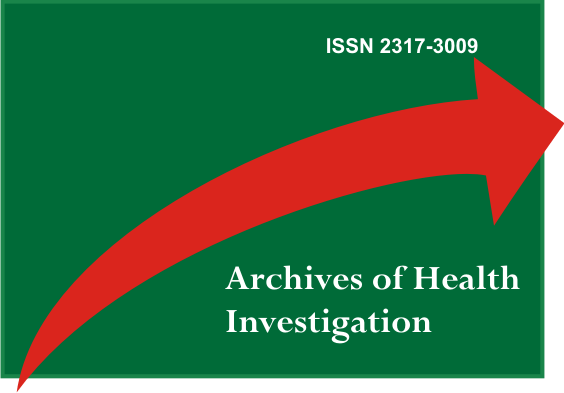Orthodontic approach in dental trauma: systematic review and meta-analysis
DOI:
https://doi.org/10.21270/archi.v5i6.1719Resumo
Introduction: There is a high prevalence of dental trauma in patients in need of orthodontic treatment, so it is important the knowledge about the orthodontic approach in cases of traumatized teeth. Thus, this study conducted a systematic review about orthodontic approach in dental trauma. Materials and Methods: Two investigators performed a systematic review with meta-analysis. MEDLINE/PubMed and Cochrane Library supplied relevant data from studies published between February 2004 and September 2015 on the relationship between dental trauma and orthodontic treatment. Results: Susceptibility to pulp necrosis was the dichotomous outcomes measure evaluated by risk ratio (RR) and the corresponding 95% confidence intervals (CI). The quality was evaluated using the Oxford Centre for Evidence-Based Medicine (EbM) guidelines. A search strategy and application of eligibility criteria enabled selection and evaluation of four studies on orthodontic treatment in traumatized teeth. In total, 1.696 patients (average age 11.6 years) with orthodontic treatment over 24.2 months were studied, and 484 had already suffered dental trauma and undergone orthodontic treatment. The primary observed sequelae after orthodontic treatment indicated greater susceptibility to pulp necrosis in traumatized teeth compared to no previous trauma. The patients with orthodontically treated traumatized maxillary incisors were more susceptible to pulp necrosis (RR: 7.6; 95% CI: 3.64 to 15.87; p= 0.00001) compared to patients with previous dental trauma to the maxillary incisors and no subsequent orthodontic treatment. Conclusion: There is no well-established protocol for these cases; such treatment must be careful and respect the healing period post-trauma, when these teeth are more susceptible to pulp necrosis and pulp obliteration.Descriptors: Tooth Injuries; Wounds and Injuries; Tooth Avulsion; Orthodontics, Corrective.
Downloads
Referências
Bastone EB, Freer TJ, McNamara JR. Epidemiology of dental trauma. A review of the literature. Aust Dent J. 2000 Mar;45(1):2-9.
Caldas AF Jr, Burgos ME. A retrospective study of traumatic dental injuries in a brazilian dental trauma clinic. Dent Traumatol. 2001 Dec;17(6):250-3.
Cioata R, Savin C, Vataman M, Maxim A, Balan A. Considerations on the epidemiology, etiology and profile of periodontal--dental injuries in preschool population in iasi county. Rev Med Chir Soc Med Nat Iasi. 2013 Jan-Mar;117(1):222-6.
Toprak ME, Tuna EB, Seymen F, Gencay K. Traumatic dental injuries in turkish children, istanbul. Dent Traumatol. 2014 Aug;30(4):280-4.
Siqueira MB, Gomes MC, Oliveira AC, Martins CC, Granville-Garcia AF, Paiva SM. Predisposing factors for traumatic dental injury in primary teeth and seeking of post-trauma care. Braz Dent J. 2013 Nov-Dec;24(6):647-54.
Fields HW, Christensen JR. Orthodontic procedures after trauma. J Endod. 2013 Mar;39(3 Suppl):S78-87.
Kindelan SA, Day PF, Kindelan JD, Spencer JR, Duggal MS. Dental trauma: An overview of its influence on the management of orthodontic treatment. Part 1. J Orthod. 2008 Jun;35(2):68-78.
Bauss O, Schafer W, Sadat-Khonsari R, Knosel M. Influence of orthodontic extrusion on pulpal vitality of traumatized maxillary incisors. J Endod. 2010 Feb;36(2):203-7.
Bauss O, Rohling J, Schwestka-Polly R. Prevalence of traumatic injuries to the permanent incisors in candidates for orthodontic treatment. Dent Traumatol. 2004 Apr;20(2):61-6.
Moher D, Shamseer L, Clarke M, Ghersi D, Liberati A, Petticrew M, Shekelle P, Stewart LA; PRISMA-P Group. Preferred reporting items for systematic review and meta-analysis protocols (PRISMA-P) 2015 statement. Syst Rev. 2015 Jan 1;4:1.
de Souza Batista VE, Junior JF, de Faria Almeida DA, de Toledo Piza Lopes LF, Verri FR, Pellizzer EP. The effect of offset implant configuration on bone stress distribution: A systematic review. J Prosthodont. 2015 Feb;24(2):93-9.
Lopes LF, da Silva VF, Santiago JF, Jr., Panzarini SR, Pellizzer EP. Placement of dental implants in the maxillary tuberosity: A systematic review. Int J Oral Maxillofac Surg. 2015 Feb;44(2):229-38.
Landis JR, Koch GG. The measurement of observer agreement for categorical data. Biometrics. 1977 Mar;33(1):159-74.
Bauss O, Rohling J, Sadat-Khonsari R, Kiliaridis S. Influence of orthodontic intrusion on pulpal vitality of previously traumatized maxillary permanent incisors. Am J Orthod Dentofacial Orthop. 2008 Jul;134(1):12-7.
Bauss O, Rohling J, Rahman A, Kiliaridis S. The effect of pulp obliteration on pulpal vitality of orthodontically intruded traumatized teeth. J Endod. 2008 Apr;34(4):417-20.
Bauss O, Rohling J, Meyer K, Kiliaridis S. Pulp vitality in teeth suffering trauma during orthodontic therapy. Angle Orthod. 2009 Jan;79(1):166-71.
Dimberg L, Arnrup K, Bondemark L. The impact of malocclusion on the quality of life among children and adolescents: A systematic review of quantitative studies. Eur J Orthod. 2015 Jun;37(3):238-47.
Andreasen JO, Bakland LK, Andreasen FM. Traumatic intrusion of permanent teeth. Part 3. A clinical study of the effect of treatment variables such as treatment delay, method of repositioning, type of splint, length of splinting and antibiotics on 140 teeth. Dent Traumatol. 2006 Apr;22(2):99-111.
Andreasen JO, Lauridsen E, Gerds TA, Ahrensburg SS. Dental trauma guide: A source of evidence-based treatment guidelines for dental trauma. Dent Traumatol. 2012 Apr;28(2):142-7.
Consolaro A. The four mechanisms of dental resorption initiation. Dental Press J Orthod. 2013 May-Jun;18(3):7-9.
Mostafa YA, Iskander KG, El-Mangoury NH. Iatrogenic pulpal reactions to orthodontic extrusion. Am J Orthod Dentofacial Orthop. 1991 Jan;99(1):30-4.
McDonald F, Pitt Ford TR. Blood flow changes in permanent maxillary canines during retraction. Eur J Orthod. 1994 Feb;16(1):1-9.
Sonmez H, Tunc ES, Dalci ON, Saroglu I. Orthodontic extrusion of a traumatically intruded permanent incisor: A case report with a 5-year follow up. Dent Traumatol. 2008 Dec;24(6):691-4.
Krishnan V, Davidovitch Z. Cellular, molecular, and tissue-level reactions to orthodontic force. Am J Orthod Dentofacial Orthop. 2006 Apr;129(4):469.e1-32.
Owman-Moll P, Kurol J, Lundgren D. Effects of a doubled orthodontic force magnitude on tooth movement and root resorptions. An inter-individual study in adolescents. Eur J Orthod. 1996 Apr;18(2):141-50.
Jang KT, Kim JW, Lee SH, Kim CC, Hahn SH, Garcia-Godoy F. Reposition of intruded permanent incisor by a combination of surgical and orthodontic approach: A case report. J Clin Pediatr Dent. 2002 Summer;26(4):341-5.
Kalwitzki M, Weiger R. An intrusion injury as an example of interdisciplinary aspects in dental traumatology: A case report. Quintessence Int. 2005 Mar;36(3):234-42.
Medeiros RB, Mucha JN. Immediate vs late orthodontic extrusion of traumatically intruded teeth. Dent Traumatol. 2009 Aug;25(4):380-5.


